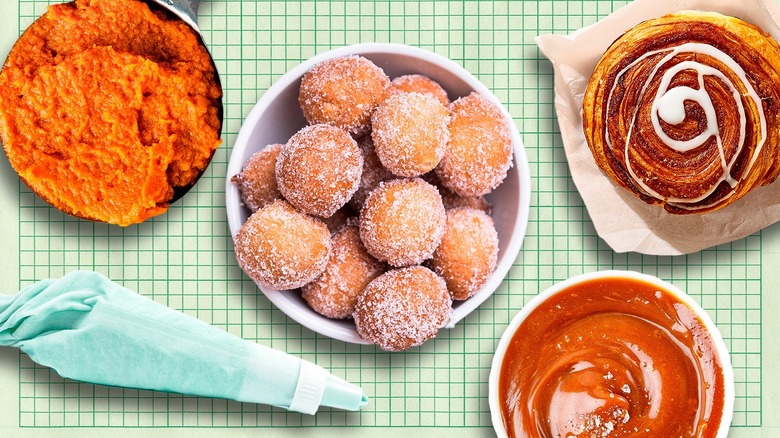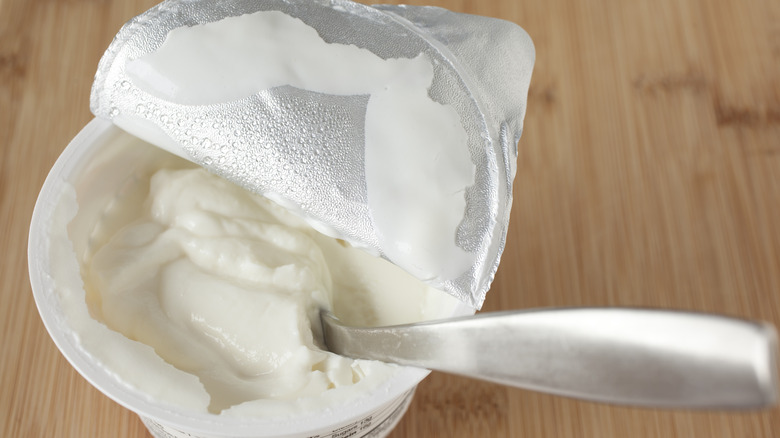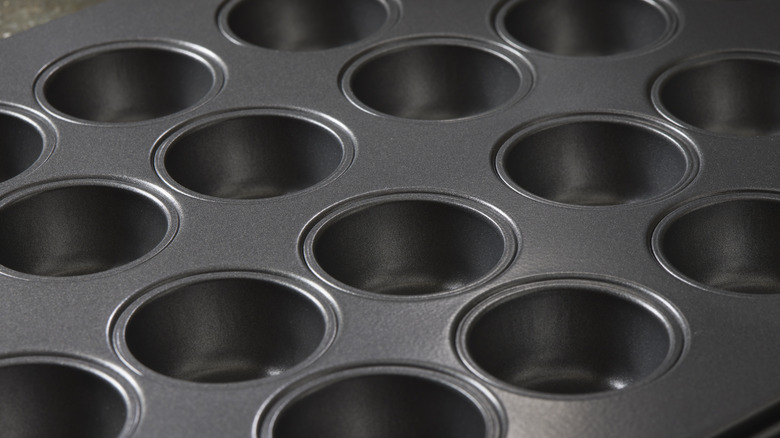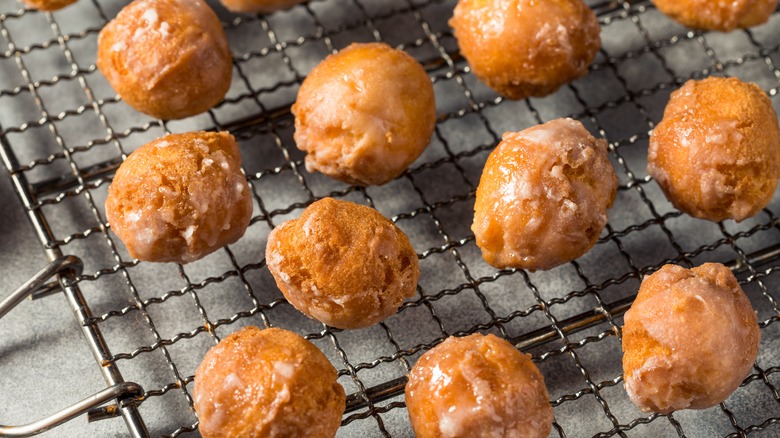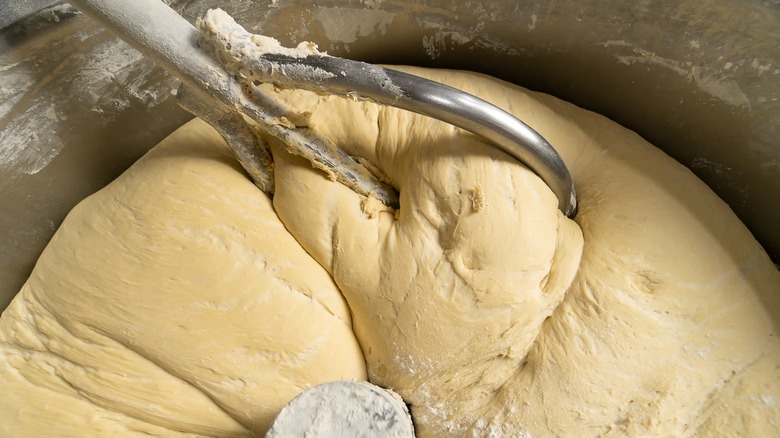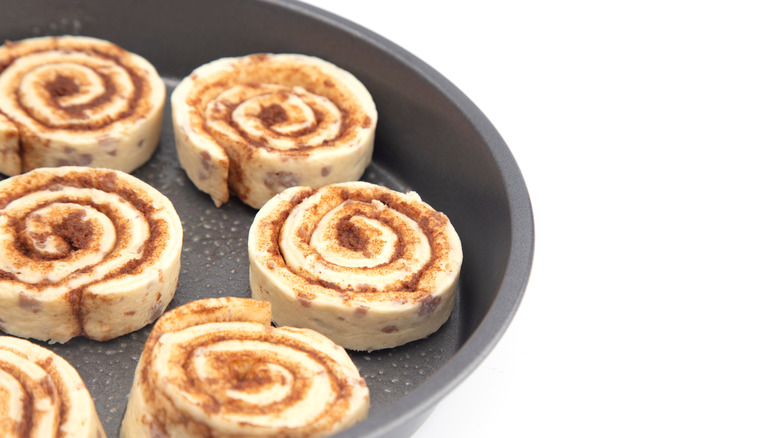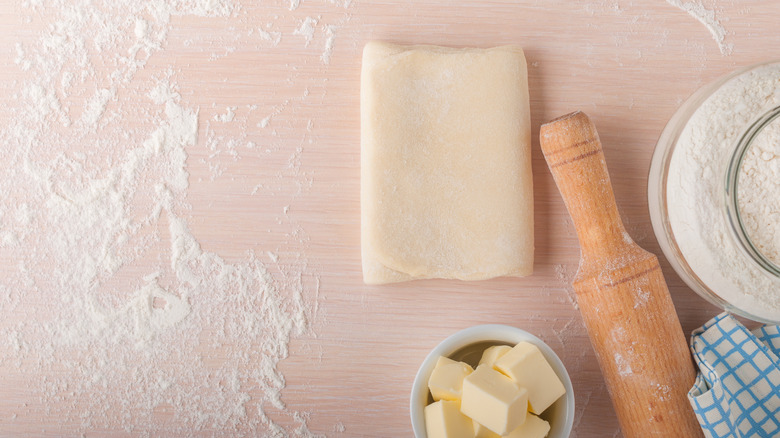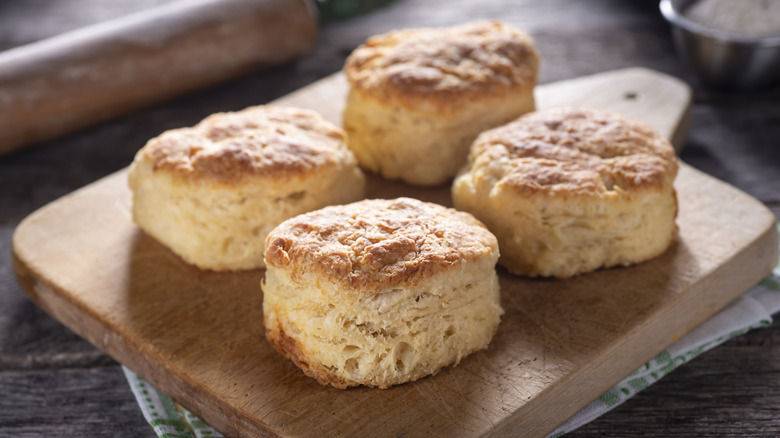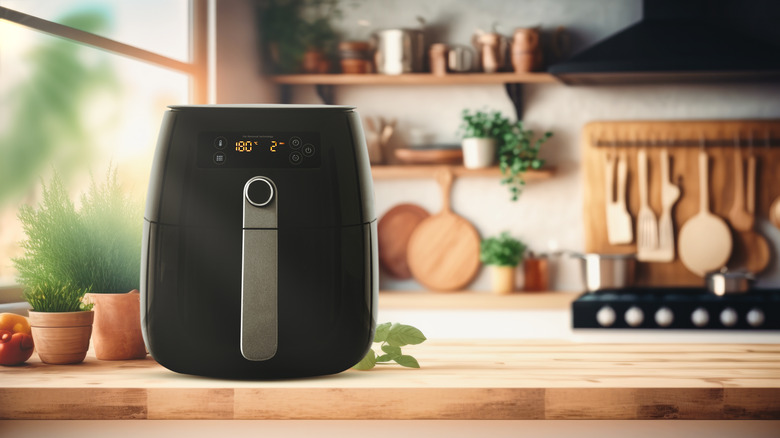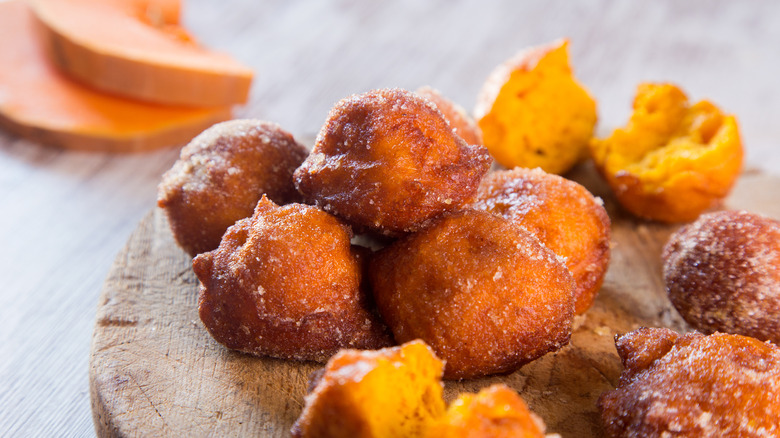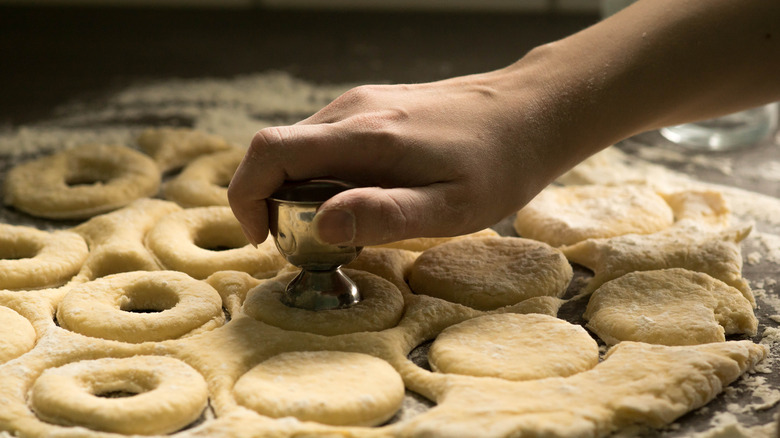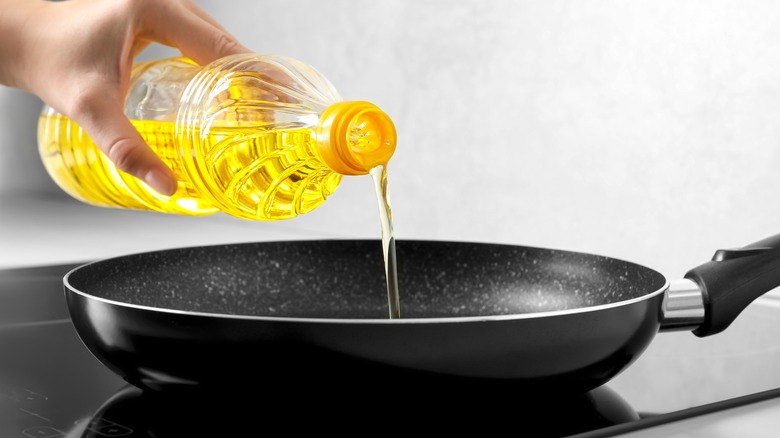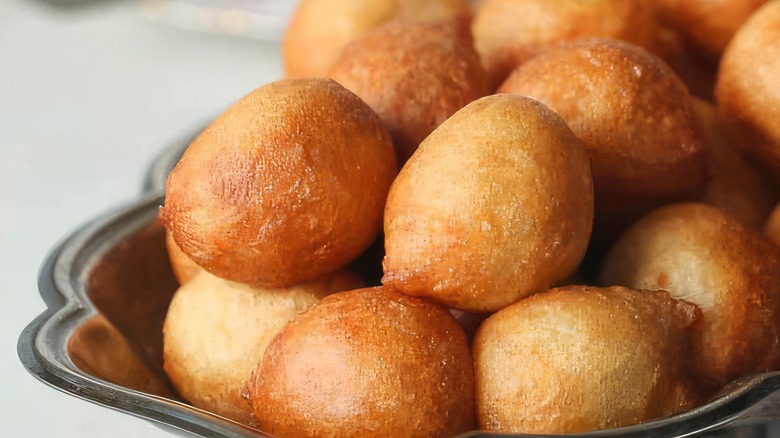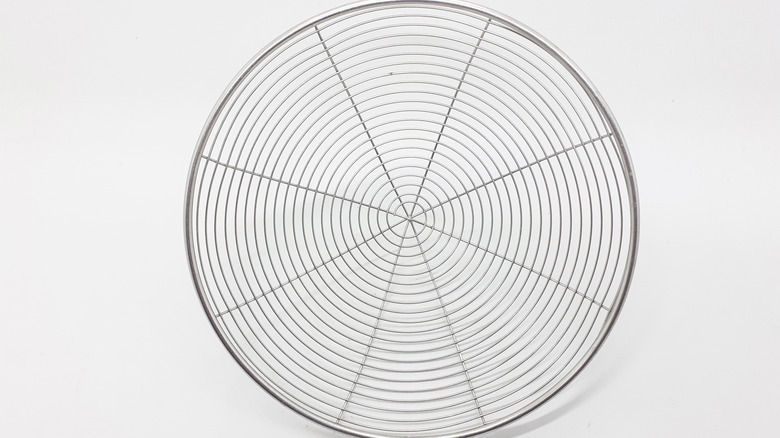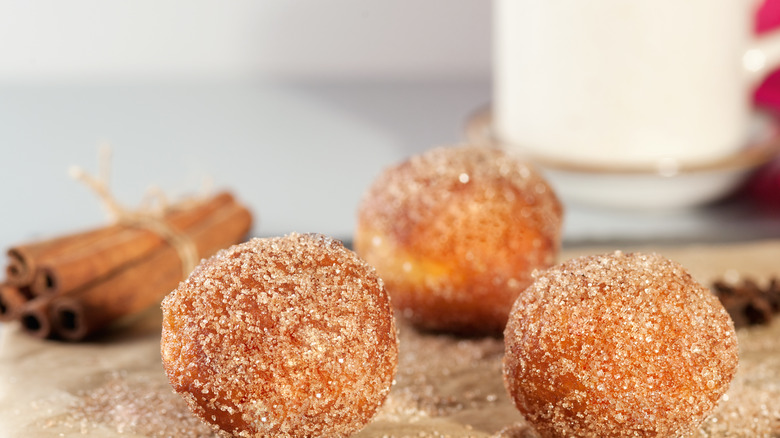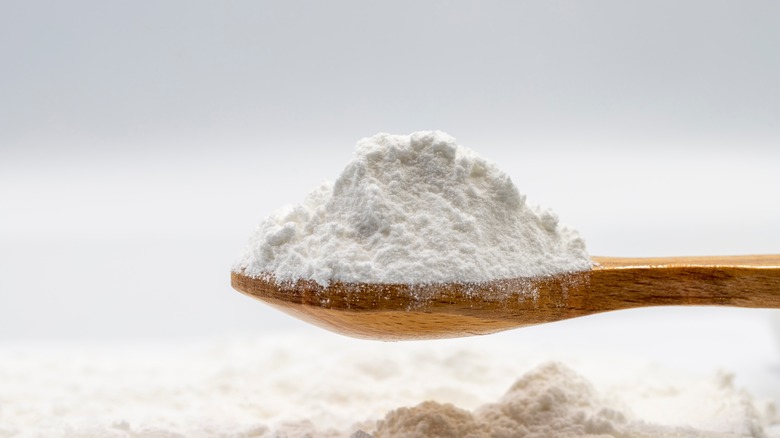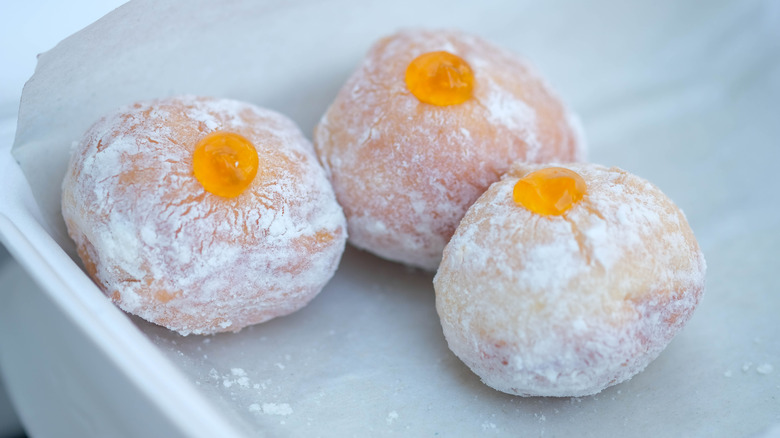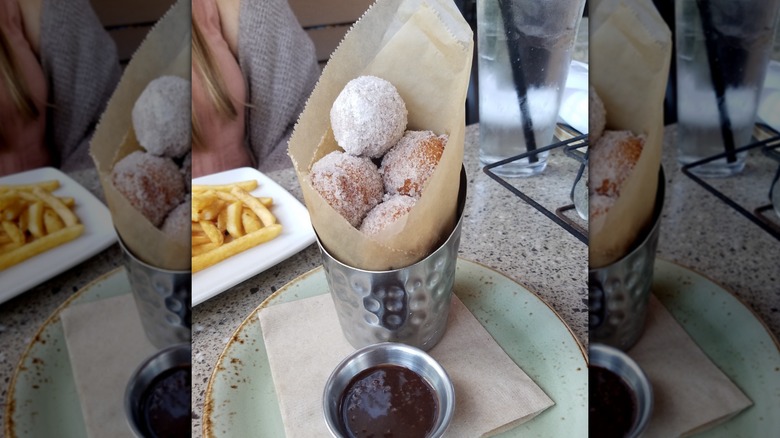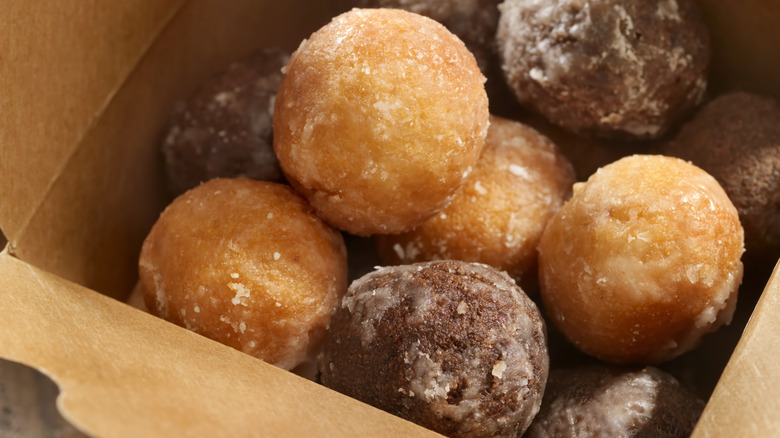18 Tips You Need For Making Donut Holes
Donuts are a great sugary start to the morning — although we can't be sure one alone is very filling. The better alternative is to make donut holes, which are perfectly convenient to pop into your mouth when you walk past a plate of them in the kitchen. Although smaller than standard donuts, donut holes don't skimp out on the flavor. You can coat them in a frosting, glaze, or sugar and fill them with a rich jelly or sweet spread.
Donut holes may be an easy option to pick up from your local donut chain, but they're much more challenging to make at home. As experienced home donut makers who love to make these sweet treats for special occasions, we've curated a list of our best tips for making delicious donut holes at home that are just too good to resist, including some shortcuts that will bypass having to make the perfect dough or achieve the ideal fry.
Try a two-ingredient donut hole recipe to start
Making your own donut holes at home might seem like a bit of a daunting task, but it's actually easier than you'd think — especially with these shortcuts. For delicious donut holes, you'll only need two ingredients: self-rising flour and whole-milk yogurt. The self-rising flour is a staple ingredient in our kitchen because it already contains leavening agents in it. The acid in the yogurt interacts with these chemicals and gives your donut holes the characteristic puff that they need to come out of the fryer perfectly light.
You'll want to use 1½ cups of flour for each cup of yogurt. Once you mix the two ingredients, you can plop it right into the oil and fry until golden brown on all sides. You're not limited to just plain yogurt either; try substituting in a strawberry or lemon yogurt for an even more flavorful donut hole.
Use a muffin tin to help your donuts keep their shapes
Baked donut holes are the alternative for bakers who get a bit unnerved thinking about sputtering frying oil. But, opting to bake your donuts rather than fry them opens up a new challenge of its own. How do you get the donut holes to keep their round shape without going flat on a baking sheet?
The absolute best vessel for baking donut holes is your handy mini muffin tin. You'll want to concoct a normal quickbread recipe, which is like one you'd use for banana or pumpkin bread. An extra egg yolk and a scant amount of cornstarch will help transport the bready texture into donut territory, while a quick brush of melted butter and roll in cinnamon sugar will create the sweet treat of your dreams. Bake your donut holes in the greased muffin tin and serve them with a delicious dipping sauce. How easy is that?
Try an old-fashioned recipe when you're ready to fry
Frying donuts is a labor of love — and of patience. If you're a donut novice, we recommend starting your frying experience with a simple donut variety, rather than going straight for the plush, Dunkin' Donuts glazed munchkin ideal. Old-fashioned donuts (and donut holes), for example, tend to be easier to fry at home than other types because the unique shape and texture are more forgiving than the sheen and perfectly smooth coating of a store-bought glazed donut.
Frying old-fashioned donut holes also requires a lower oil temperature than other types of donuts. Once plopped into the 340 F oil, the donuts will rise when they are finished cooking, which is a clear-cut sign to the donut maker that the holes are ready to be pulled. There's less guessing involved with this variety, which makes it ideal for someone who's still dipping their toes into the world of fried foods.
Give your yeasted dough enough time to properly rise
Yeasted donut holes are a slightly more tedious option to make than baked donuts — but not just because yeasted donuts are almost always often fried rather than baked. Not only do you have to worry about babysitting your donut holes floating around in a vat of hot oil, but you also have to put in the time to make sure that your tiny holes achieve the perfect rise. Otherwise, when you take a bite of your donuts, you'll face nothing but grease, stodge, and an overwhelming feeling that you may have done something terribly wrong.
The reason why your yeasted donuts may not have adequately risen and developed the ideal airy texture is that you didn't follow the proving directions adequately. Depending on the recipe, your donut holes may need up to a couple of hours to rest before you plop them into the oil. Although this might seem like a lot of time, the texture you get from a properly-made donut hole is worth it.
Repurpose your canned cinnamon rolls
We're all about taking the easy way out when it comes to baking, including turning to seemingly unconventional ingredients to enhance our favorite recipes and make them much easier. If you're tight on time but still want to whip up a batch of donut holes for a special brunch, turn to a roll of store-bought canned cinnamon rolls. Simply pop and unfurl the can, remove the cinnamon rolls, and use a knife or small cutter to cut your tiny donut holes. While most versions of this kitchen hack involve cutting the whole donuts and frying up the extra holes, you can also use your cutter to cut only the smaller shapes.
Perhaps the best part about this shortcut is that the cinnamon roll cans come with icing that can be easily thinned into a glaze with a splash of milk. After the donut holes have sufficiently cooled, cover them in the glaze and serve.
Give your puff pastry dough new life in your recipe
There are just some items everyone should always have in their freezer, including a pint of homemade tomato sauce, a bag of frozen fruit for smoothies, and a box of puff pastry. While this ingredient is often used for Greek spanakopita or homemade apple turnovers, it can also be used to make donuts in a flash. The puff pastry is filled with layers of butter and dough that will give your donut holes a unique croissant-like structure.
You'll want to start by thawing out your roll of dough first. We probably don't need to be the ones to tell you that water (or, in this case, ice crystals) and hot oil aren't a good combination. Once your dough is completely thawed, you can press out tiny pieces with your cutter and transfer them directly to a skillet with hot oil. These puff-pastry shortcut donut holes are great tossed in cinnamon sugar or covered in your favorite glaze.
Skip the homemade dough for canned biscuits instead
Canned biscuits are your best friend for baking a delicious batch of homemade donut holes. Not only it is a relatively cheap option to pick up from the refrigerator section at almost any grocery store, but it will keep you far away from having to deal with misbehaving yeast or leavening agents that are a bit too far past their expiration date.
You'll want to start making these donuts by cutting out your small donut hole pieces and popping them into a skillet with oil. As with all types of donuts, it's important to use hot oil for these donut holes to ensure that the outside gets perfectly crispy rather than oily and stodgy. Once your donuts have fried on both sides, transfer them to a paper towel before sprinkling them with your garnish of choice.
Try cooking your donuts holes in an air fryer
Air fryers are one of the best kitchen appliances ever created. These small countertop machines are perfect for everything from bringing your French fries back to life to even cooking an entire cake. One of our favorite ways to use the air fryer is to cook up some donuts.
If you're making an easy air fryer donuts recipe, swap out your standard dough for crescent dough. Then, bake the donuts in your already pre-heated air fryer for about seven minutes, and then they'll be ready to go. You can also use your standard yeasted donut dough recipe in your appliance You'll want to bake using a greased air fryer basket and place the donut holes at least an inch apart to account for the expansion as they bake.
Use pumpkin purée autumnal flavor
You can add flavor to your donut holes by more than just using a coating of cinnamon and granulated sugar. Add a fruit purée to infuse more flavor into your treats. In the cool autumn months, a batch of fried pumpkin donut holes will be perfect for eating with a pumpkin-spiced latte. Not only does this purée keep each bite flavorful, but it will also ensure that your donuts stay perfectly moist when you fry them. Pop your donut holes into the fryer and coat them with a mixture of cinnamon sugar once they come out.
It might seem a bit strange to indulge in pumpkin during the spring months. You can also use other fruit to add an extra layer of moisture to your donut holes, including puréed blueberries or apple pieces. Just make sure to keep your fruit pieces small so they mesh well with the batter.
Use a shot glass to cut donut holes
One of the most critical parts of making your donut holes is shaping them. If you start with a slab of stretched dough, you can easily slice your donuts with the help of the bottom of a shot glass. It's a good alternative if you don't have a donut cutter in your gadget drawer. If you're looking for super-small donut holes, you might even consider using a bottle cap to cut the perfect one-bite dessert. Aim for donut holes that are about a half-inch thick.
There are some instances where a shot glass won't help you adequately cut your donuts. If you're scooping a cake donut, which is made without yeast, you'll need something that can easily pick up the batter. This is where a cookie scoop or ice cream scoop can come in handy. It's important to note that when you drop the batter into the fryer, it may splash back at you — so wear long sleeves or protective gloves.
Always use hot, fresh oil for frying
One of the biggest mistakes anyone can make with donut holes is not starting with hot oil. You never want to start your donut holes in cold oil because it will cause the donuts to soak in the oil rather than cook. In turn, you'll be relegated to greasy donut holes that you're better off throwing away than eating. Instead, you'll want the oil hot enough that it quickly cooks and seals the outside of the donut holes.
You should also always fry your donuts in fresh oil rather than the stuff you used for fried chicken the night before. Although it is true that frying oil can be used again, reused oil tends to hold in the flavor of whatever you cooked with it last. Plus, some frying oils start to degrade at 375 F, which means using leftover oil may impart some unexpected and harsh flavor notes on your donuts.
Avoid frying too many donuts holes at once
Maintaining consistent cooking temperature is very important for getting perfectly crisp donut holes. If you make the small mistake of adding too many to your fryer at once, you'll risk bringing down the temperature. This causes unequal cooking temperatures and times between batches, which may mean that you have some donuts that are overcooked and others that come out raw.
You should only fry a few donut holes at a time and slowly work in batches. Use your first batch as the tester batch to get your time down. Then, add the same amount of donuts to the pot after that. You can also keep a thermometer handy to ensure that your oil stays within the perfect cooking temperature.
Use a metal spider skimmer to grab the donut holes from the fryer
The hard part of making donuts also comes when you need to carefully fish out the holes from the vat of hot oil. While some people may prefer to use long kitchen tongs to pull out the donut holes, you will risk deflating or breaking the pieces when you pick them up out of the hot oil. Plus, it will also take you a long time to pluck the individual donut holes from the oil, which means you'll risk overcooking some of them.
When making donuts at home, your most important tool is your metal spider skimmer. The handle of this kitchen gadget is long enough to prevent you from getting hot oil on your skin, while the wide scoop allows you to easily pick up the pieces. You can also use this skimmer to carefully release the donuts away from you in the oil, which will further prevent oil from splattering.
Roll your donut holes in a sugar mixture immediately after frying
Your donuts won't be complete without the perfect sugary coating. It covers your lips with every bite and makes these donut bites oh-so-satisfying. But if you wait to add a sprinkle of cinnamon sugar to your donut holes, you'll risk it not sticking — and instead falling all over your shirt instead. The important timing rule for your donuts is to always add your granulated sugar and powdered sugar while your donuts are still warm and steaming.
However, if you're opting for an icing or a glaze, you'll want to make sure the donuts are slightly cooled before you add your finishing touches. The heat emulating from the donuts will cause the icing to fall off the side of the donut or prevent anything from sticking. A room-temperature donut is ideal for setting your icing on top of your donut without cracking or causing aesthetic damage.
Add extra powdered sugar for the perfect donut consistency
Perfecting your donut glaze isn't easy. You'll want it to be thinner than your standard cupcake frosting but not so thin that it slides off your donut holes without holding. The simple way to thicken up a runny donut glaze is to add more powdered sugar to it. Unlike other types of sugar, the powdered sugar will dissolve well in cool milk, which will prevent a gritty, grainy texture on your donut.
Once you have your milk and vanilla in a bowl, you'll want to stick to slowly adding your powdered sugar until you get the texture you want. The standard is about 2 cups of powdered sugar for a ¼ cup of milk and a teaspoon of vanilla. You can also tweak your recipe with a bit of lemon zest, rum extract, or maple syrup.
Use a piping bag to fill your donut holes carefully
Donut holes can take on all the same qualities of regular donuts — including supporting a hefty jelly filling. Naturally, though, since donut holes are smaller than standard donuts, you have to be very careful not to overfill them but also make sure that your holes have enough filling for a little bit of it in every bite.
You'll first want to give your donut holes a gentle prick with a chopstick before inserting your piping bag filled with your jam, jelly, or filling. You'll want to only insert enough filling until you start to feel the donut grow and feel some resistance on the bag in your hand. Alternatively, you can also use a sponge bottle to fill your donuts with ease.
Serve them with a dipping sauce
Although donut holes are easy to pop in your mouth in passing, they're even more delicious when they're served with a side dipping sauce. The accompaniment you choose will depend on the flavor of your donuts. If you're making a seasonal pumpkin or a plain-Jane old-fashioned donut, a salted caramel dipping sauce is an ideal accompaniment. Or, for apple cider donuts, consider making a cider-infused caramel sauce to amplify the tangy fruit flavor.
As an alternative, you can also go with a chocolaty sauce. A simple chocolate ganache or a hot fudge could elevate a dense cake donut and introduce new flavors into your recipe that you never thought were possible. If you don't want to risk overfilling your donuts, you might also consider swapping it out with a side of jam for dipping.
Pop your donut holes in skillet to bring them back to life
There's no arguing with the fact that donuts are always the best the day that they're fried. But if you have a handful of donut holes left on day two, you can bring them back to life with the help of your skillet and salted butter. Place your donut holes in the pan with the melted butter and cook the sides of the donut holes until they're golden brown. Cooking the holes will give you a brioche-like texture and they are best when they are sprinkled with a bit of water and sealed with a lid to trap in the steam. It's important to remember that some types of donuts are not ideal for this reheating method; granulated sugar-covered and glazed donuts have the best results.
If you're short on time, you might also consider the quickest way to rescue stale donut holes: the microwave. A mere 15 seconds wrapped in a damp paper towel will ensure that the donut stays perfectly soft.
Static Media owns and operates Tasting Table and Mashed.
